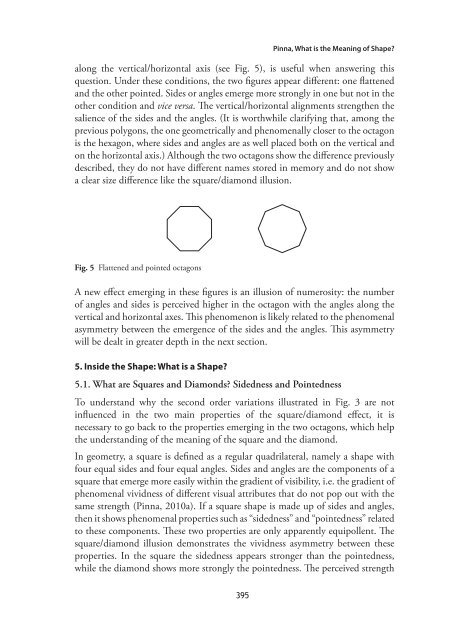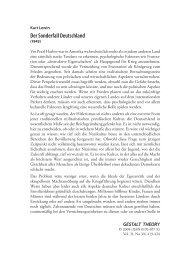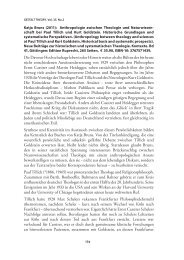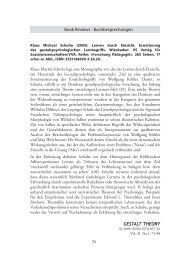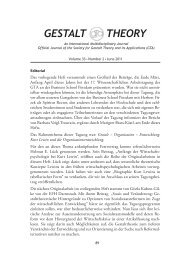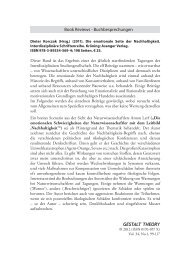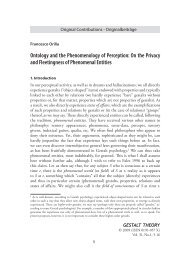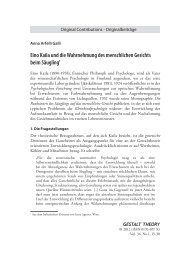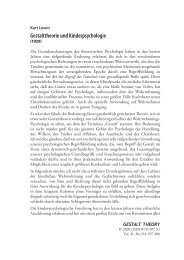What is the Meaning of Shape? - Gestalt Theory
What is the Meaning of Shape? - Gestalt Theory
What is the Meaning of Shape? - Gestalt Theory
Create successful ePaper yourself
Turn your PDF publications into a flip-book with our unique Google optimized e-Paper software.
395<br />
Pinna, <strong>What</strong> <strong>is</strong> <strong>the</strong> <strong>Meaning</strong> <strong>of</strong> <strong>Shape</strong>?<br />
along <strong>the</strong> vertical/horizontal ax<strong>is</strong> (see Fig. 5), <strong>is</strong> useful when answering th<strong>is</strong><br />
question. Under <strong>the</strong>se conditions, <strong>the</strong> two figures appear different: one flattened<br />
and <strong>the</strong> o<strong>the</strong>r pointed. Sides or angles emerge more strongly in one but not in <strong>the</strong><br />
o<strong>the</strong>r condition and vice versa. The vertical/horizontal alignments streng<strong>the</strong>n <strong>the</strong><br />
salience <strong>of</strong> <strong>the</strong> sides and <strong>the</strong> angles. (It <strong>is</strong> worthwhile clarifying that, among <strong>the</strong><br />
previous polygons, <strong>the</strong> one geometrically and phenomenally closer to <strong>the</strong> octagon<br />
<strong>is</strong> <strong>the</strong> hexagon, where sides and angles are as well placed both on <strong>the</strong> vertical and<br />
on <strong>the</strong> horizontal ax<strong>is</strong>.) Although <strong>the</strong> two octagons show <strong>the</strong> difference previously<br />
described, <strong>the</strong>y do not have different names stored in memory and do not show<br />
a clear size difference like <strong>the</strong> square/diamond illusion.<br />
Fig. 5 Flattened and pointed octagons<br />
A new effect emerging in <strong>the</strong>se figures <strong>is</strong> an illusion <strong>of</strong> numerosity: <strong>the</strong> number<br />
<strong>of</strong> angles and sides <strong>is</strong> perceived higher in <strong>the</strong> octagon with <strong>the</strong> angles along <strong>the</strong><br />
vertical and horizontal axes. Th<strong>is</strong> phenomenon <strong>is</strong> likely related to <strong>the</strong> phenomenal<br />
asymmetry between <strong>the</strong> emergence <strong>of</strong> <strong>the</strong> sides and <strong>the</strong> angles. Th<strong>is</strong> asymmetry<br />
will be dealt in greater depth in <strong>the</strong> next section.<br />
5. Inside <strong>the</strong> <strong>Shape</strong>: <strong>What</strong> <strong>is</strong> a <strong>Shape</strong>?<br />
5.1. <strong>What</strong> are Squares and Diamonds? Sidedness and Pointedness<br />
To understand why <strong>the</strong> second order variations illustrated in Fig. 3 are not<br />
influenced in <strong>the</strong> two main properties <strong>of</strong> <strong>the</strong> square/diamond effect, it <strong>is</strong><br />
necessary to go back to <strong>the</strong> properties emerging in <strong>the</strong> two octagons, which help<br />
<strong>the</strong> understanding <strong>of</strong> <strong>the</strong> meaning <strong>of</strong> <strong>the</strong> square and <strong>the</strong> diamond.<br />
In geometry, a square <strong>is</strong> defined as a regular quadrilateral, namely a shape with<br />
four equal sides and four equal angles. Sides and angles are <strong>the</strong> components <strong>of</strong> a<br />
square that emerge more easily within <strong>the</strong> gradient <strong>of</strong> v<strong>is</strong>ibility, i.e. <strong>the</strong> gradient <strong>of</strong><br />
phenomenal vividness <strong>of</strong> different v<strong>is</strong>ual attributes that do not pop out with <strong>the</strong><br />
same strength (Pinna, 2010a). If a square shape <strong>is</strong> made up <strong>of</strong> sides and angles,<br />
<strong>the</strong>n it shows phenomenal properties such as “sidedness” and “pointedness” related<br />
to <strong>the</strong>se components. These two properties are only apparently equipollent. The<br />
square/diamond illusion demonstrates <strong>the</strong> vividness asymmetry between <strong>the</strong>se<br />
properties. In <strong>the</strong> square <strong>the</strong> sidedness appears stronger than <strong>the</strong> pointedness,<br />
while <strong>the</strong> diamond shows more strongly <strong>the</strong> pointedness. The perceived strength<br />
!"#$%&'()''!"#$%#&'(#$$"<br />
!"#$%&'%$"(%)(#*&*+%,-%'"#.(/


